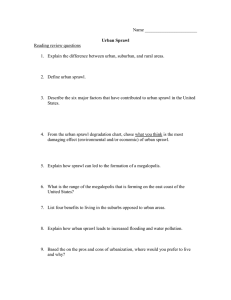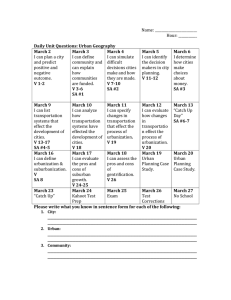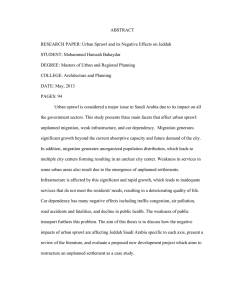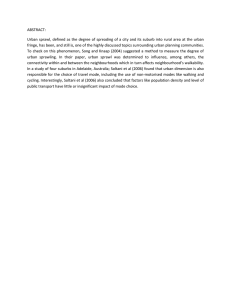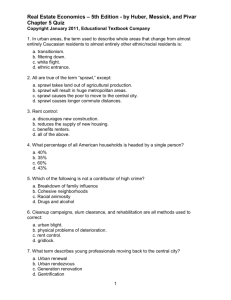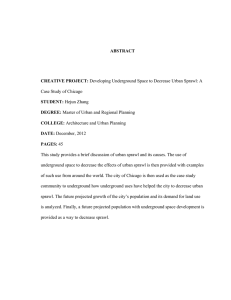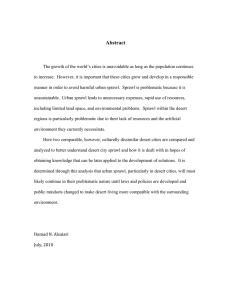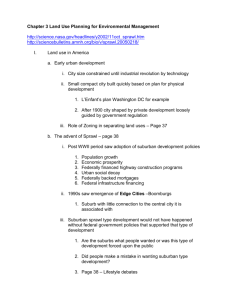IRJET-Reasons of Causing Urban Sprawl and it’s Effect on Daily Life
advertisement
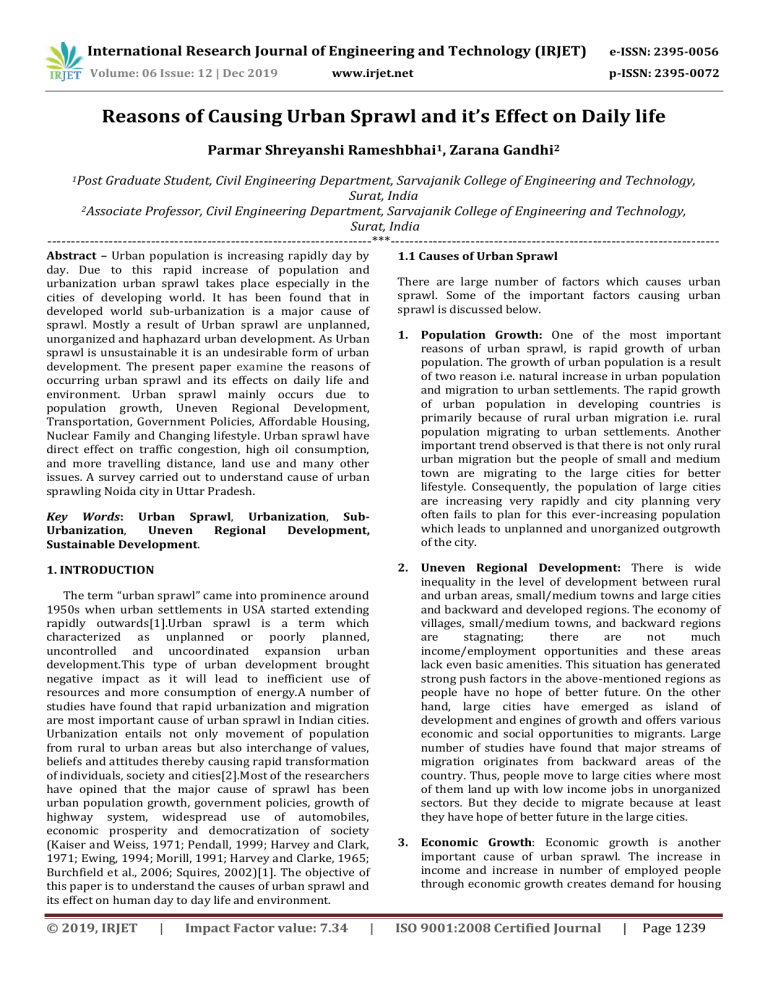
International Research Journal of Engineering and Technology (IRJET) e-ISSN: 2395-0056 Volume: 06 Issue: 12 | Dec 2019 p-ISSN: 2395-0072 www.irjet.net Reasons of Causing Urban Sprawl and it’s Effect on Daily life Parmar Shreyanshi Rameshbhai1, Zarana Gandhi2 1Post Graduate Student, Civil Engineering Department, Sarvajanik College of Engineering and Technology, Surat, India 2Associate Professor, Civil Engineering Department, Sarvajanik College of Engineering and Technology, Surat, India ---------------------------------------------------------------------***---------------------------------------------------------------------Abstract – Urban population is increasing rapidly day by day. Due to this rapid increase of population and urbanization urban sprawl takes place especially in the cities of developing world. It has been found that in developed world sub-urbanization is a major cause of sprawl. Mostly a result of Urban sprawl are unplanned, unorganized and haphazard urban development. As Urban sprawl is unsustainable it is an undesirable form of urban development. The present paper examine the reasons of occurring urban sprawl and its effects on daily life and environment. Urban sprawl mainly occurs due to population growth, Uneven Regional Development, Transportation, Government Policies, Affordable Housing, Nuclear Family and Changing lifestyle. Urban sprawl have direct effect on traffic congestion, high oil consumption, and more travelling distance, land use and many other issues. A survey carried out to understand cause of urban sprawling Noida city in Uttar Pradesh. Key Words: Urban Sprawl, Urbanization, SubUrbanization, Uneven Regional Development, Sustainable Development. 1. INTRODUCTION The term “urban sprawl” came into prominence around 1950s when urban settlements in USA started extending rapidly outwards[1].Urban sprawl is a term which characterized as unplanned or poorly planned, uncontrolled and uncoordinated expansion urban development.This type of urban development brought negative impact as it will lead to inefficient use of resources and more consumption of energy.A number of studies have found that rapid urbanization and migration are most important cause of urban sprawl in Indian cities. Urbanization entails not only movement of population from rural to urban areas but also interchange of values, beliefs and attitudes thereby causing rapid transformation of individuals, society and cities[2].Most of the researchers have opined that the major cause of sprawl has been urban population growth, government policies, growth of highway system, widespread use of automobiles, economic prosperity and democratization of society (Kaiser and Weiss, 1971; Pendall, 1999; Harvey and Clark, 1971; Ewing, 1994; Morill, 1991; Harvey and Clarke, 1965; Burchfield et al., 2006; Squires, 2002)[1]. The objective of this paper is to understand the causes of urban sprawl and its effect on human day to day life and environment. © 2019, IRJET | Impact Factor value: 7.34 | 1.1 Causes of Urban Sprawl There are large number of factors which causes urban sprawl. Some of the important factors causing urban sprawl is discussed below. 1. Population Growth: One of the most important reasons of urban sprawl, is rapid growth of urban population. The growth of urban population is a result of two reason i.e. natural increase in urban population and migration to urban settlements. The rapid growth of urban population in developing countries is primarily because of rural urban migration i.e. rural population migrating to urban settlements. Another important trend observed is that there is not only rural urban migration but the people of small and medium town are migrating to the large cities for better lifestyle. Consequently, the population of large cities are increasing very rapidly and city planning very often fails to plan for this ever-increasing population which leads to unplanned and unorganized outgrowth of the city. 2. Uneven Regional Development: There is wide inequality in the level of development between rural and urban areas, small/medium towns and large cities and backward and developed regions. The economy of villages, small/medium towns, and backward regions are stagnating; there are not much income/employment opportunities and these areas lack even basic amenities. This situation has generated strong push factors in the above-mentioned regions as people have no hope of better future. On the other hand, large cities have emerged as island of development and engines of growth and offers various economic and social opportunities to migrants. Large number of studies have found that major streams of migration originates from backward areas of the country. Thus, people move to large cities where most of them land up with low income jobs in unorganized sectors. But they decide to migrate because at least they have hope of better future in the large cities. 3. Economic Growth: Economic growth is another important cause of urban sprawl. The increase in income and increase in number of employed people through economic growth creates demand for housing ISO 9001:2008 Certified Journal | Page 1239 International Research Journal of Engineering and Technology (IRJET) e-ISSN: 2395-0056 Volume: 06 Issue: 12 | Dec 2019 p-ISSN: 2395-0072 www.irjet.net as well as better housing with more living space on better location. 4. Transportation: A good transport network is a must for economic growth of a city. However, this development of transport specially the expressways and highways cause urban sprawl. Since, the sprawl is automobile dependent, the construction of highways facilitated movement of people from farther distance to city, thus opening these areas for residential development. 5. Government Policies: Government policies are important cause of urban sprawl. In developing countries, the government policies have contributed significantly to rapid urbanization in large cities causing urban sprawl. 6. Affordable Housing: The land and property cost in city is quite high which a large section of population can not afford. On the other hand, the property cost outside the city limits is low. Therefore, people who can not afford to buy a home in the city settle down in the sprawl area. Also, people who desire larger living space gets attracted to this zone as it provides affordable housing. 7. Nuclear Family: The nuclear families generate more demand for housing in comparison to joint family. Also, the requirement of per capita living space is more as compared to joint family. Thus, nuclear family system generates demand for more houses as well as more living space. 8. Changing lifestyle: With the technology playing its role it also pleases to the people to find their own life outskirts. Living in consolidation is being avoided as it may be messy sometimes. Easy transportation methods, infrastructure and connectivity through web never makes them to miss on the city life in the suburbs. People enjoy their life in their own small world which decrease their social life. Besides the above-mentioned factors, there are many other minor factors such as independence of location, land buyer attitude, legal disputes, physical aspects, development and property tax, public regulation, road width, failure to enforce planning policies, large lot size, county living desire, etc. (Bhatta, 2010). impact on infrastructure and the sustainability of cities. In most cases, sprawl translates to an increase in the cost of transport, public infrastructure and of residential and commercial development. Moreover, sprawling metropolitan areas require more energy, metal, concrete and asphalt than do compact cities because homes, offices, and utilities are set farther apart. It is evident that urban sprawl has negative impacts on both air quality and public health, which affects the human condition. This results in health issues for inner-city residents due to high emission levels causing air pollution. People with health problems such as asthma, heart and lung disease may also suffer more when the air is polluted (Ewing, R., 1994). Must not be used. Other font types may be used if needed for special purposes. Moreover, sprawling metropolitan areas require more energy, metal, concrete and asphalt than do compact cities because homes, offices, and utilities are set farther apart. Urban sprawl adds to the urban divide, pushing social segregation along economic lines that result in spatial difference in wealth and quality of life across various parts of cities. Authorities lack the ability to predict urban growth and, urban poor land rights, fail to provide land for the urbanizing poor, which are one of the main factors driving people to the periphery of towns, associated with urban sprawl in developing countries. Other features typically associated with sprawl include overdependence on personal motorized transport coupled with a lack of alternatives, limited housing options, and urban spaces that discourage pedestrian traffic and People are forced to spend more time commuting longer distances to reach their jobs, homes, schools and shopping areas, also include environment deterioration, traffic congestion, air pollution, crime, poverty, racial tension, poor schools, poor public services etc. So Therefore, the rich people escaped from the inner cities in order to escape from the problems above and look forward to high quality of life. At a time when we desperately need to reduce our energy use, sprawled developments increase our energy consumption per person, for increased gasoline, home heating, and electricity use. Old-fashioned neighborhoods with compact housing gives feel of belonging and community. But due to urban sprawl Families are more isolated. Overall urban sprawl is an issue that must be addressed and handled before it continues to spiral out of control. 2. Urban Sprawl in Noida Urban sprawl is a multifaceted concept, which includes the spreading outwards of a city and its suburbs to its outskirts to low-density and auto-dependent development on rural land, high segregation of uses, and various design features that encourage car dependency. It has been argued that urban sprawl is the root of many environmental problems. Urban sprawl also has a negative A survey was carried out in Noida city of Uttar Pradesh in the year 2016. One of the objectives of survey was to understand the causes of urban sprawl. The city of Noida having an area of 20,316 ha lies entirely within the district of Gautam Buddha Nagar sharing its boundary with Delhi in the west. The city is located in the Yamuna basin in the area between River Yamuna and Hindan. The area is an almost flat alluvial plain with a gently sloping surface from north-east to south-west. The city of Noida was developed under the policy framework of National Capital Region © 2019, IRJET ISO 9001:2008 Certified Journal 1.2 Effect of Urban Sprawl | Impact Factor value: 7.34 | | Page 1240 International Research Journal of Engineering and Technology (IRJET) e-ISSN: 2395-0056 Volume: 06 Issue: 12 | Dec 2019 p-ISSN: 2395-0072 www.irjet.net (NCR) plan which aimed at stopping congestion in Delhi by preventing in-migration. Thus, to divert population to Noida destined for Delhi, alternative planned residential and industrial site was provided to people at much lower price compared to Delhi. Proximity to Delhi, cheaper land, and planned development of city has led to emergence of Noida as one of the fastest growing cities where population is doubling every decade since 1991 and is projected to keep doubling till 2031. The population of Noida was 1,46,514 in 1991 which increased to 3,05,058 in 2001. It further increased to 6,37,272 in 2011 and as per Noida Master Plan2031, its population is projected to reach 25 Lakhs. The result of survey is presented in Table 1. Table 1: Distribution of Households on the Basis of Nativity and Native Place (in per cent) Localities Native Noida of Native place Yes No UP Bihar Delhi Other Mamura 13.3 86.6 46.6 26.6 0 13.3 Sector 10 0 100 76.6 16.6 3.3 3.33 Sector 12 16.6 83.3 56.6 3.33 6.6 16.6 Sector 26 23.3 76.6 20 13.3 13.3 30 Sector 44 20 80 26.6 13.3 33.3 6.6 Sector 52 13.3 86.6 33.3 16.6 30 6.6 Chalera 16.6 83.3 43.3 36.6 0 3.3 Sector 105 0 100 40 46.6 0 13.3 Total 12.9 87.0 49.2 24.8 12.4 13.4 | Impact Factor value: 7.34 Thus, the survey reveals that backwardness of source regions of migrants, employment/income opportunities, proximity to Delhi, availability of cheap land, planned development, availability of affordable houses built by Noida Authority ad private builders and credit facility at cheaper rates are main causes of urbanization and urban sprawl in Noida. 3. CONCLUSION As per questionnaire survey result, backwardness of the area is the major driver of migration as one can see large number of migrants from Bihar (24.88 per cent) which is farther away in comparison to Haryana (3.87 per cent) which shares its boundary with Noida. Almost all families (87.56 per cent, excluding Delhi) who migrated to Noida came to city due to availability of job/income opportunities. Nearness to Delhi and lower rental values were other important consideration for them to migrate to Noida. This reveals that major stream of migration to Noida has been from backward areas of country and economic opportunities and proximity to Delhi being the most important motive of migration. sample paragraph. The main reason of families which shifted to Noida from Delhi was lower land value in Noida in comparison to Delhi. These families were not able to buy a house in Delhi because of exorbitant land values. They were able to purchase a house in Noida. So, having their house was the major consideration for most of the families migrating from Delhi. Another important consideration was location of their work place in Noida. © 2019, IRJET Key informants revealed that employment opportunities created initially through industrial development, cheap land and proximity to Delhi were main reasons for people to migrate to Noida. Later on, planned development of the city specially infrastructure development by the Noida Authority made Noida more attractive to migrants. The diversification of economic activity, development of health and education sector, availability of affordable housing through Noida Authority and private builders have helped Noida to emerge as a vibrant city and strengthening of pull factors for migrants. | The study analyses the causes of urban sprawl which is an unsustainable form of development. The major causes of Urban sprawl are mainly due to population growth, Uneven Regional Development, Transportation, Government Policies, Affordable Housing, Nuclear Family and Changing lifestyle. As it has been proven that urban sprawl has led to adverse effects on our environment, and in return the human condition has also been affected. It has been found in the primary survey carried out in the Noida city of Uttar Pradesh that rapid urbanization, regional disparities, employment/income opportunities, proximity to Delhi, availability of cheap land, affordable housing and credit facility at cheaper rates are the main causes of sprawl in the city. REFERENCES [1] Sudhir Kumar Sinha, “Causes of Urban Sprawl: A comparative study of Developed and Developing World Cities,” Volume-03 Issue-09 September-2018. [2] Arpit Tiwari, Vidhi Goel, URBAN SPRAWL Causes, Effects and Remedies for Indian cities, .Volume 11, Issue 11 Ver. I (November. 2017), PP 61-67. [3] Andrew Brunner, “The Effects of Urban Sprawl on Daily Life”. [4] Bhatta, B. Analysis of urban growth and sprawl from remote sensing data. (2010). ISO 9001:2008 Certified Journal | Page 1241
